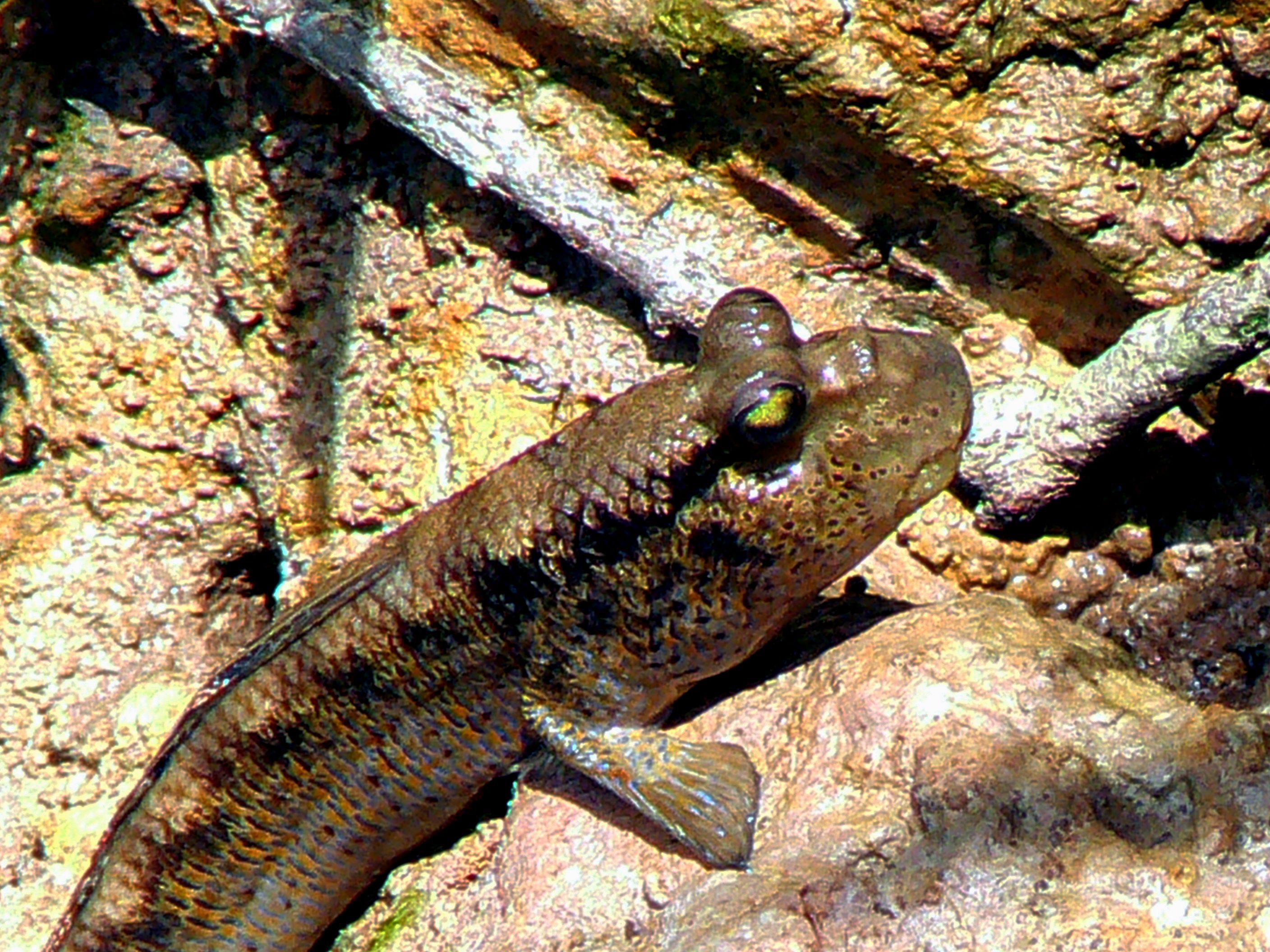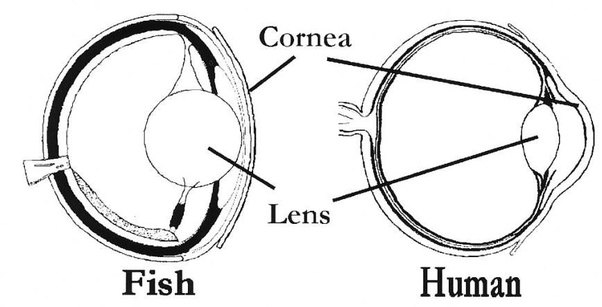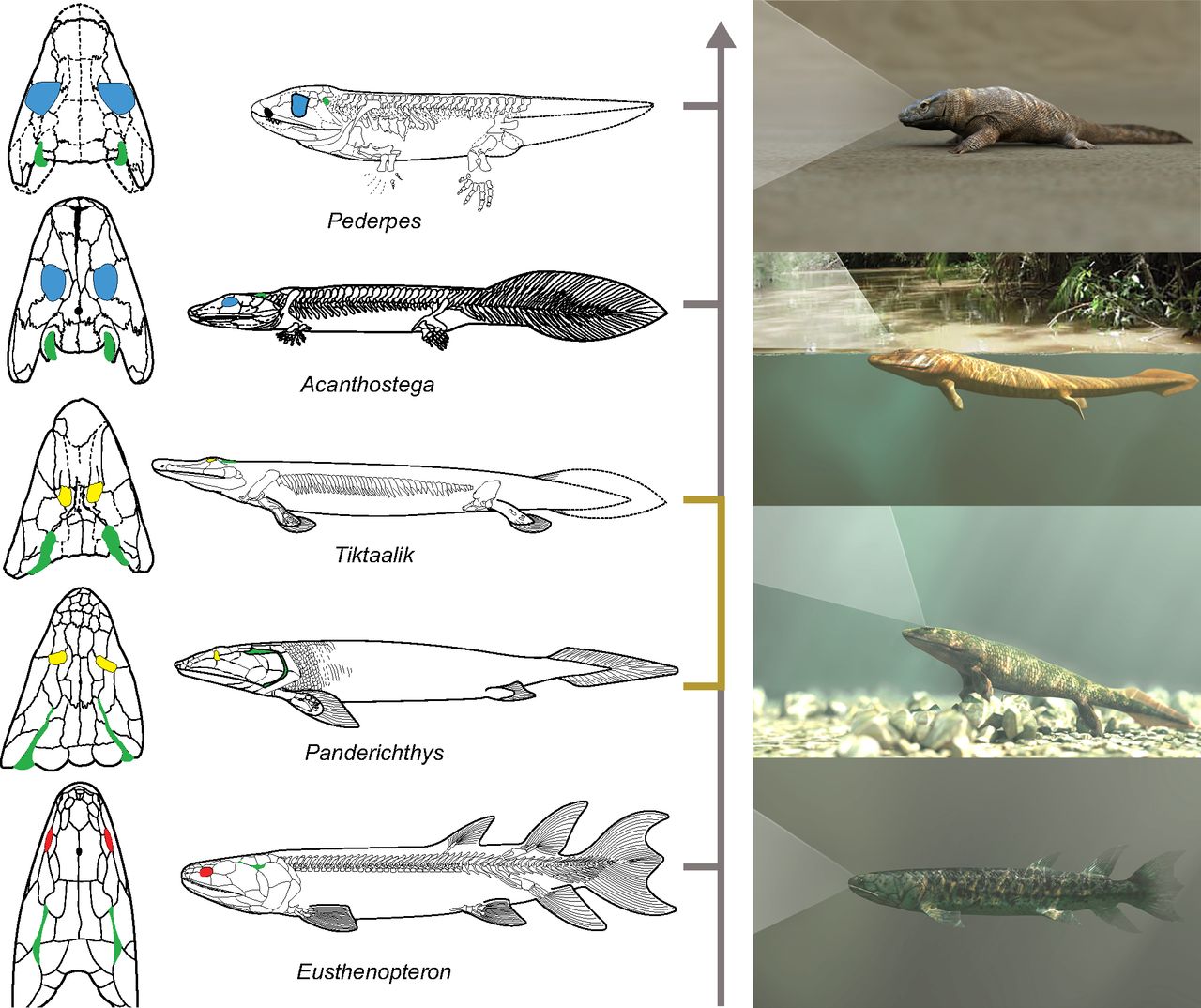Why the first vertebrates to leave the ocean learned to see before they could walk
Advanced eyesight might have paved the way for better brains and complex thought
Around 370 million years ago, late in what we call the Devonian era, the first fish began to crawl out of the primordial ooze and onto the shores of a new, terrestrial world. Compared to today, this period of Earth’s history was mild and dry. For these early vertebrates, which had until this point been confined to the seas, it was a desperate charge into uncharted territory. They escaped an oxygen-poor and highly competitive aquatic environment and emerged onto land, which was full of tasty insects and plants. The invaders did well. Vertebrate biodiversity exploded, and the result is the reptiles, amphibians, birds and mammals – including us – that now dominate the surface of the Earth.

A modern mudskipper. Researchers believe these fish venture temporarily onto land in the same way that the first fish to leave the ocean did.
Walking before you can see?
It takes a lot more than gumption to invade a new habitat. The fossil record shows a string of adaptations that gradually transformed aquatic creatures into terrestrial ones. Flimsy fins became strong, bony limbs that could walk on land. Gills gave way to lungs, making breathing air possible. The development of a long, mobile neck made it easier to survive by allowing these creatures to look down and see food on the ground beneath their feet. This arduous transition from water to land took roughly 30 million years.

This chart shows a number of Devonian tetrapods, recreated from fossils, in relation to the age of fossilized tetrapod tracks found in Poland.
While the changes associated with learning to walk instead of swim are relatively well understood, much less work has been done on how the visual capability of our pre-historic ancestors changed during the water-to-land transition. Just like movement, the physics of vision are also very different in water than in air. Everything looks blurry underwater for land-lovers like us because water bends light differently than air, causing it to focus away from the sweet spot on the retina. Aquatic animals have a different eye shape to accommodate the way light bends in their environment.
These differences beg an obvious question: how did the first vertebrates to walk on land manage to survive if their eyesight was adapted for the ocean? A provocative new study published by researchers from Northwestern University and Pitzer and Scripps Colleges argues that the invasion of land by vertebrates required vision that was already adapted for land. The study is unique in the way it combines physical measurements recorded by paleontologists, like eye socket size, with computer models to simulate the capabilities of extinct animals in terrestrial and aquatic environments.

Differences in fish and human lens shapes are responsible for differences in refraction and the ability to see in air or water.
A tree grows in the lab
The researchers first constructed phylogenetic trees of related species of tetrapods – four-limbed vertebrates – to help them pick out patterns in tetrapod anatomy across evolutionary time. They selected 59 groups of closely related species from across the spectrum of early terrestriality, including groups with flimsy fins, groups with proper limbs with fingers and toes, and everything in between.
Armed with evolutionary trees and data on the skull length and eye socket size of each species from previously published studies of fossil records, the team analyzed how much eyes changed over time. They were hoping to find evidence of selective pressure, which is what happens when a single feature becomes more important to survivability than others, and evolves more rapidly. And that’s exactly what they saw: a shift to favor larger eye sockets and eyeballs well before the evolution of proper walking limbs with digits fingers and toes.
Seeing triple
Overall, eye size tripled during the transition from finned to digital tetrapods. But eye growth alone doesn’t necessarily mean that early vertebrates were adapting to seeing better on land. To answer that question, the researchers turned to computational visual ecology. Larger eyes usually mean larger pupils, the part of the eye that lets light in to stimulate the light-sensitive cells in the back. The team used eye size data from fossil records to estimate pupil size, and in turn used those sizes to predict a number of important visual functions in both air and water.
What they found was a massive increase in visual performance in the air, and negligible increases in water. These transitional tetrapods, with terrestrial eyes but still no proper walking limbs, could see over 100 times further than their aquatic, finned predecessors. They also had an effective field of view of 2 million times the size on land, meaning they were much more capable of detecting prey. As eye size increased, researchers noticed that they moved from the side of the head to the top, probably to take advantage of this amazing improvement in visual capability without having to leave the water entirely. In other words, before permanently settling on land, these early vertebrates probably adopted a “crocodile-type” hunting strategy that allowed them to see through air even as they lived in water.

The study's proposed evolutionary scenario with eye socket size and vision changes.
Eyes on the brain
But why does it matter that eyes got bigger before fleshy fins became bony limbs? There are some interesting theories. Better eyesight means it’s easier to find prey, limiting the energy wasted on searching for food. This could have enticed early vertebrates to venture onto land to feed, spurring the development of stronger limbs and other features of terrestrial animals.
Long-range vision also has interesting implications for brain development. In the paper, the researchers argue that the super-powered eyes of early, crocodile-like tetrapods allowed them to take advantage of the abundant opportunities of a relatively deserted terrestrial habitat.
Because of their better eyes, early tetrapods had to develop the neural circuity to interpret and comprehend an influx of new information about their surroundings. For the first time, they could see things far in the distance, long before they had to react. They had time to think things through and consider their options. Did that bug look tasty enough to chase down? What was the fastest way to get over there? Were there any predators lingering nearby?
The ability to plan, instead of just react, represents a major step in neural development, and uses a different arrangement of neurons and signals. Perhaps it was long-range vision that kick-started the development of the neuronal structures needed to plan, ultimately leading to the complex brain structures of modern mammals, birds, and reptiles.
This provocative study complicates the accepted view of the evolution of terrestrial vertebrates by placing the eyes and vision in an early and central role. In what they call the “Buena Vista hypothesis,” the researchers argue that the new and extensive information offered by better vision gave early tetrapods abundant new opportunities on land. These opportunities, they believe, were central in driving the evolution of the limbs to visit, and eventually occupy, the land beyond the water we now call home.
Featured study
MacIver, M. A., Schmitz, L., Mugan, U., Murphey, T. D., & Mobley, C. D. (2017, March 7). Massive increase in visual range preceded the origin of terrestrial vertebrates. Proceedings of the National Academy of Sciences. Proceedings of the National Academy of Sciences. https://doi.org/10.1073/pnas.1615563114